For months
Chuck Smith of Washington Street
Purveyors in Lexington, Va., and I had discussed, in near
rapturous terms, what it would be like to visit the ten year old
Virginia wines. Since the rebirth of Virginia winemaking in the
1970s, no single year had seen an alignment of the planets like what
occurred in 1998. By that year, winemakers had identified some
better vineyards, growers had begun to identify better sites, the
industry had begun to identify some grape varietals with sites and
soils and winemakers knew better how to implement technology to
avoid winemaking errors. But most importantly, the Virginia weather
that year was most unlike Virginia. Hot, dry, dusty days left corn
scorching in the fields and apples shriveled on the limb.
Governor Gilmore sought to have the
federal government declare much of Virginia an agricultural disaster
area and ultimately declared a State of Emergency
(Ex. Order 36 (98)). But while farmers clamored for
assistance, grape growers grinned. They watched a vintage of
unprecedented potential develop in their vineyards and, ultimately,
in their cellars. And the fruit was glorious.
The summer of ‘98 also saw a number of now well known Virginia
winemakers come of age: Luca Paschina
had been at the helm of
Barboursville
Vineyards for but 7 years while
Michael Shaps (then of
Jefferson Vineyards) had
been making wine for even less time. For
James and Debra Vascik of
Valhalla, ‘98 marked
their first estate vintage. None had seen a Virginia vintage like
this. Different fruit requires different decisions. Any one of a
hundred decisions they might make - beginning with a decision to
pick the fruit - could ruin the fruit or ruin the juice that would
become wine. Excellent weather and most excellent fruit: but were
the winemakers up to the challenge?
 Shep
and Jane Rouse, owners of
Rockbridge Winery,
offered the situs for this retrospective tasting and, as it turned
out, the glassware and other tasting accouterments. Aided by Shep,
Chuck and I selected eight representative red wines from the
vintage. As word of the tasting spread, interest grew; the
possibility of a tasting dinner diminished. We settled for a “mere”
tasting. Shep
and Jane Rouse, owners of
Rockbridge Winery,
offered the situs for this retrospective tasting and, as it turned
out, the glassware and other tasting accouterments. Aided by Shep,
Chuck and I selected eight representative red wines from the
vintage. As word of the tasting spread, interest grew; the
possibility of a tasting dinner diminished. We settled for a “mere”
tasting.
To taste blind or not was our next hurdle. With Cabernet Sauvignon,
Cabernet Franc, Merlot, a blended Cab that included a wee bit of
Touriga Nacional, as well as Syrah all at the ready, a blind tasting
lent itself to a bohemian air of a palate orgy. Just what the hell
wine would be in one hand while you cupped another in your mouth?
But if not a blind tasting, then would the safety of knowing who was
in your glass lend itself to empirically knowing just what the ‘98s
produced? After all, if we know Luca Paschina of Barboursville made
wine #2 or Michael Shaps made wine # 6, would we really appreciate
the wine for what it was or rate it more for who it was. The palpable regard for both Paschina
and Shaps reaches a fevered pitch within some Virginia oeneophile
circles. And with Shep and Jane in the room, would their presence
color the tasters’ analysis of their wines, the Rockbridge Cabernet
or the Desheil Merlot, one of the Virginia Governor’s Cup winners in
the lineup?
We opted for a single blind tasting, knowing the identity of the
selected wines, but not knowing the pour order. In retrospect, it
worked well. More on that later. With Shep setting out the tasting
regimen - no talking, 20 point scoring, etc. - we plowed through
eight Virginia reds, ordered as follows:
 Jefferson
Cabernet Franc Glendower Estate Vineyard 1998 Jefferson
Cabernet Franc Glendower Estate Vineyard 1998
The Glendower Estate is known and respected for the quality of its
fruit. Michael Shaps was but then a new name on the winemaking
scene, and this vintage helped make it one to be remembered.
A brick to garnet rimmed wine. Drying tannins, like dried roses.
Bing cherry and eucalyptus notes, but with an acidic bite. The
finish is very short. A correct wine, but one that is just past
peak. It easily ranks as the group’s least favorite and mine as
well.
Group Rank:8
BEB: 8
Find Jefferson Vineyard wines
Linden
Hardscrabble Red 1998
Jim Law holds a place among
Virginia winemakers much like that of his vineyard: remote yet
welcoming to those who make the effort, indifferent to trends and
regarded higher than most any other. Yet this wine was, as Shep
later commented, “a real surprise” insofar as it did not score
particularly high with anyone.
A youthful red - probably the youngest looking and displaying the
biggest tannins in the group - that offered up leather, mocha, pine
resin, and smoky, green bell pepper; at first herbaceous, but then
evolving into a meaty wine with notes of molasses and cedar. At
first it showed a closed, tight fruit profile with a well-heeled
structure. Damn, it’s a chameleon of a wine that changes, evolves
and improves each time I taste and re-taste it. It’s a shame this
wasn’t decanted longer, for if given time to reach its potential, it
would have scored higher.
Group Rank:6
BEB: 5
Find Linden Vineyards wines
A comment here before the next wine: My initial objection to a blind
tasting had been premised on the number of different wines: Cabs,
Cab Francs, Merlots and Syrah. But as it turned out, the Syrah
served as an unintended ringer for all of the other Bordeaux
grape-based wines.
Valhalla Syrah 1998
James and Debra Vascik are iconoclasts in the Virginia wine
industry. The Vasciks have taken time to train at various California
wineries including Dunn. When interviewed by the Wine Spectator
(Nov. 30, 2002 issue), Jim Vascik, whose day job is that of a
neurosurgeon, remarked, “people who can’t keep up should sell out.”
So much for Southern hospitality. We took Jim at his word to see if
he should join those ranks.
Jeezuuuhss, what a funky nose! Some decided brett here and more than
what may have been intended. Definite coffee, red currant, dark
fruits, smoke, rosemary and pine resin ... and a rear end full of
brett. Oh, and maybe some cedar.
Group Rank: 6
BEB: 7
Find Valhalla Vineyards wines
That this wine scored as it did probably reflects more of the fact
that it played the role of a defacto spoiler than of its individual
quality. Some of us scored it low for a perceived brett problem.
Others, it turned out, scored it low due to it being so different
from all of the other wines. One taster scored it at the top of the
list due to his preference for Syrah. Had we eliminated the taint of
his varietal preference, the wine would have sunk lower in the
ranking.
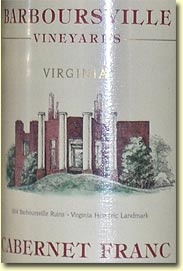 Barboursville
Cabernet Franc 1998 Barboursville
Cabernet Franc 1998
Luca Paschina has a love affair with Virginia. After assessing the
winery for its Italian owners, the Zonin wine empire, he reported
that winemaking couldn’t be done here, that nothing was right: not
the soil, not the weather, nothing. And when then asked what should
be done with the enterprise, he responded with, “Send me.” He was on
a flight back to Virginia the next day.
The rim may be bricked, but the core deepens to a garnet. A great
nose bounds from the glass with currant, smoke, leather and
sandalwood. A meaty wine with dried rose-like tannins and maybe a
bit of that tell tale Virginia pine.
Group Rank: 5 (aw, what the heck does a group know about wine!)
BEB: 1 (I knew from the nose what this was - one damn fine wine!)
Find Barboursville Vineyards wines
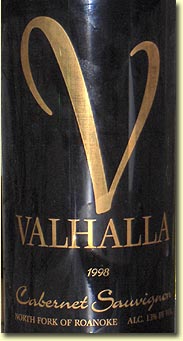 Valhalla
Cabernet Sauvignon Reserve 1998 Valhalla
Cabernet Sauvignon Reserve 1998
Juxtaposed with the Linden, and perhaps due to its “drink now”
readiness, this wine took the collective body’s first choice. An
orange tinged rim of wine brightened to a ring of garnet, then to a
deep red at its very core. Dried, round tannins delivered loads of
ripe black cherries, currants, leather and cedar. It’s a wine of
great length. The depth of cherry vaguely reminded me of Cali Pinot,
but that’s another story, should I survive the lynching for making
such a comparison.
Group Rank: 1
BEB: 4
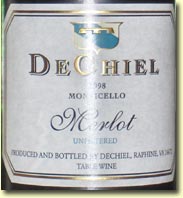 Rockbridge
Winery DeChiel Merlot 1998 Rockbridge
Winery DeChiel Merlot 1998
Shep has been making wine in Virginia for, well, we’ll leave it at
“a very long time.” He knows his way around a winery. That he
insisted on a blind tasting speaks well of his integrity and
intellectual curiosity.
This appeared as yet another bricked rimmed
wine that might be well past peak as it sat before me. It wasn’t. It
struck me as somewhat initially bretty in the nose. But fortunately,
whatever it was blew off. In its place followed blackberry, smoke,
smoked meats, plum, spice (cedar, maybe), pine and chocolate. A bit
of mint perhaps appeared on the finish. This was not Syrah, but I
wasn’t sure which other wine it could be. Whatever it was, it
floated on the palate with a bit of a lighter mouthfeel that I would
have preferred, but I liked it nonetheless.
Group Rank: 4
BEB:3
Find Rockbridge Winery wines
 Barboursville
Cabernet Sauvignon Reserve 1998 Barboursville
Cabernet Sauvignon Reserve 1998
Another fairly young wine with a deep burgundy core shading to
orange to brick thinly on the rim. The nose delivers some candy
apple while the palate has dusty dry, rose notes, raspberry, then
spice - like sandalwood - and black cherry. It finishes with a
distinct mocha note. At times an element of pine pops up.
Group Rank: 3
BEB: 2
Rockbridge Winery Red Wine (formerly “Cabernets”) 1998
Blind tastings are humbling, as we all learned this evening. But
Jane Rouse made the classic comment when asked to assess this wine.
“I don’t like it! It has that unpleasant green bell pepper thing I
dislike about Virginia wines,” she said. It turned out to be her own
wine: a blend of 72% Cabernet Sauvignon, 15% Cabernet Franc, 10%
Merlot and 3% Touriga Nacional.
I found it to be a solid burgundy color from its rim to its core.
Initially, the nose is a bit funky, as in “off,” as in “put off” or
“off putting.” It seems to clean itself up, however, opening into a
chewy wine with cherry, raspberry, leather, sandalwood, smoke and
pine resin. I never quite forgave it for its first impression.
Group Rank: 2
BEB: 6
Each year the Virginia Department of Agriculture hosts a
blind tasting of Virginia wines, awarding the top wine the Virginia
“Governor’s Cup.” It is no mistake that three of the last seven
Governor’s Cup awards hail from the ‘98 vintage. We had the good
fortune to include all three in this tasting: Barboursville Cabernet
Sauvignon Reserve (‘07 winner), Rockbridge DeChiel Merlot (‘01
winner) and the Valhalla Syrah (‘00 winner). What it says of the
wines .... or of the judges awarding the distinction .... that none
of the Governor Cup winners took first or second in this tasting
(the B’ville Cabernet Reserve did score a third place ranking by the
group and 2 of the 3 made it into my top 3 wines), I cannot say. It
could mean any one of a number of things that might best be left to
those more discerning than myself.
After pulling off the blinders, we decided we to lighten the evening
with some food and less formal discussion, and perhaps see how badly
some Virginia Chardonnays from the ‘98 vintage might have oxidized.
We tasted each of the Chards with eyes, if not mouths, wide open. To
describe most of us as skeptical would not begin to scratch our
sentiment. But after the first sip, we took a second look in
amazement.
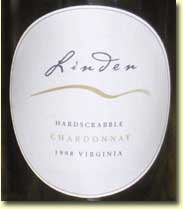 Linden
Hardscrabble White (100% Chardonnay) 1998 Linden
Hardscrabble White (100% Chardonnay) 1998
Undoubtedly and easily, the surprise wine of the night. People kept
picking up the bottle to look and see if it really listed itself as
a ‘98. It did. And it was delectable. An excellent wine with crisp
acidity, yet great length and great depth. An attack of apple,
butter, butterscotch and an etching of hazelnut. The finish is long
and clean with acidity that strips out the butterscotch. This tastes
much like an aged Grand Cru Chablis or lighter Puligny Montrechet.
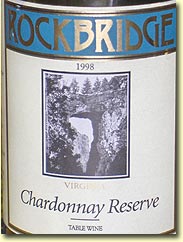 Rockbridge
Winery Chardonnay Reserve 1998 Rockbridge
Winery Chardonnay Reserve 1998
Oxidized. Very oaky and toasty .... and thoroughly, completely and
utterly oxidized.
Rockbridge Winery Reserve Chardonnay 1996
Oh my freaking, geeky self! A white ‘96 ... from Virginia ....
that’s drinkable? This was beyond merely “drinkable.” It was
delicious. A good wine with apple fruit and lemon and citrus
flavors. But it lacked the depth and nuance of the Linden
Hardscrabble White.
But what did this all mean? What did this tasting accomplish? After
all, any arbitrary selection of thirteen people can plop themselves
down, fill up glasses and proceed to swill wine and pontificate in
sozzled voices. And any collection of Virginia wine chauvinists can
gather to celebrate a wine made in Virginia. The meaning of this
tasting is simply this: wine geeks are not known for being shy about
opinions. They often take painful pleasure in parsing distinctions
that rarely have the diameter of ... a yeast cell. If you have ever
lurked about a wine board on the web, you know full well how painful
the parsing can be. At times, bulletin board wine geeks make lawyers
look noble.
 The
absence of endless, individual parsing over distinctions without a
difference pleasantly marked the evening. The collective, general
uniformity from the tasting group’s comments, individual wine
rankings aside, made the event that much more remarkable. A French
wine intern working for Rockbridge Winery,
Vincent Benezit, best summed up the consensus, “These are
some excellent wines.” The weight of his comment came not so much
from what Benezit said, but what he did not say. He never qualified
the wines by saying, as is sometimes heard from the national wine
press, “good for a Virginia wine” with the backhanded compliment
fully intended to insult. The absence of any qualifier emphasized
the wines’ quality. The wines represent not just good wines from
Virginia. They represent excellent wines. Period. The
absence of endless, individual parsing over distinctions without a
difference pleasantly marked the evening. The collective, general
uniformity from the tasting group’s comments, individual wine
rankings aside, made the event that much more remarkable. A French
wine intern working for Rockbridge Winery,
Vincent Benezit, best summed up the consensus, “These are
some excellent wines.” The weight of his comment came not so much
from what Benezit said, but what he did not say. He never qualified
the wines by saying, as is sometimes heard from the national wine
press, “good for a Virginia wine” with the backhanded compliment
fully intended to insult. The absence of any qualifier emphasized
the wines’ quality. The wines represent not just good wines from
Virginia. They represent excellent wines. Period.
Boyce (BEB)
Boyce's Index Page
Contact Boyce
BACK TO THE
TOP
 Link
to Gang of Pour Home Page Link
to Gang of Pour Home Page
 Link
to Gang of Pour Site Index (Table of Contents) Link
to Gang of Pour Site Index (Table of Contents)


|

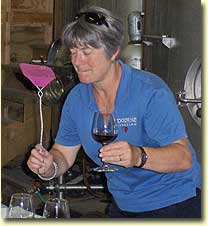 If
bees are the bane of grape harvest, then flies are the bane of an
empty fermentation room. The quick staccato buzzing of flies moving,
alighting and moving again was punctuated with the occasional WHAP!
of the flyswatter that Jane welded in one hand while balancing a
glass of wine in the other. The picnic tablecloths covering the
folding tables configured in a big square, the graveside folding
chairs and the stacks of cardboard boxes filled with empty bottles
and glasses aren’t likely to appear on wine magazines’ covers. But
then, real tasters don’t much bother with lifestyle mags for
suggestions on wine. We held no expectations of California glamour;
just confidence that our Virginia quest would be rewarded.
If
bees are the bane of grape harvest, then flies are the bane of an
empty fermentation room. The quick staccato buzzing of flies moving,
alighting and moving again was punctuated with the occasional WHAP!
of the flyswatter that Jane welded in one hand while balancing a
glass of wine in the other. The picnic tablecloths covering the
folding tables configured in a big square, the graveside folding
chairs and the stacks of cardboard boxes filled with empty bottles
and glasses aren’t likely to appear on wine magazines’ covers. But
then, real tasters don’t much bother with lifestyle mags for
suggestions on wine. We held no expectations of California glamour;
just confidence that our Virginia quest would be rewarded. Shep
and Jane Rouse, owners of
Rockbridge Winery,
offered the situs for this retrospective tasting and, as it turned
out, the glassware and other tasting accouterments. Aided by Shep,
Chuck and I selected eight representative red wines from the
vintage. As word of the tasting spread, interest grew; the
possibility of a tasting dinner diminished. We settled for a “mere”
tasting.
Shep
and Jane Rouse, owners of
Rockbridge Winery,
offered the situs for this retrospective tasting and, as it turned
out, the glassware and other tasting accouterments. Aided by Shep,
Chuck and I selected eight representative red wines from the
vintage. As word of the tasting spread, interest grew; the
possibility of a tasting dinner diminished. We settled for a “mere”
tasting. Jefferson
Cabernet Franc Glendower Estate Vineyard 1998
Jefferson
Cabernet Franc Glendower Estate Vineyard 1998